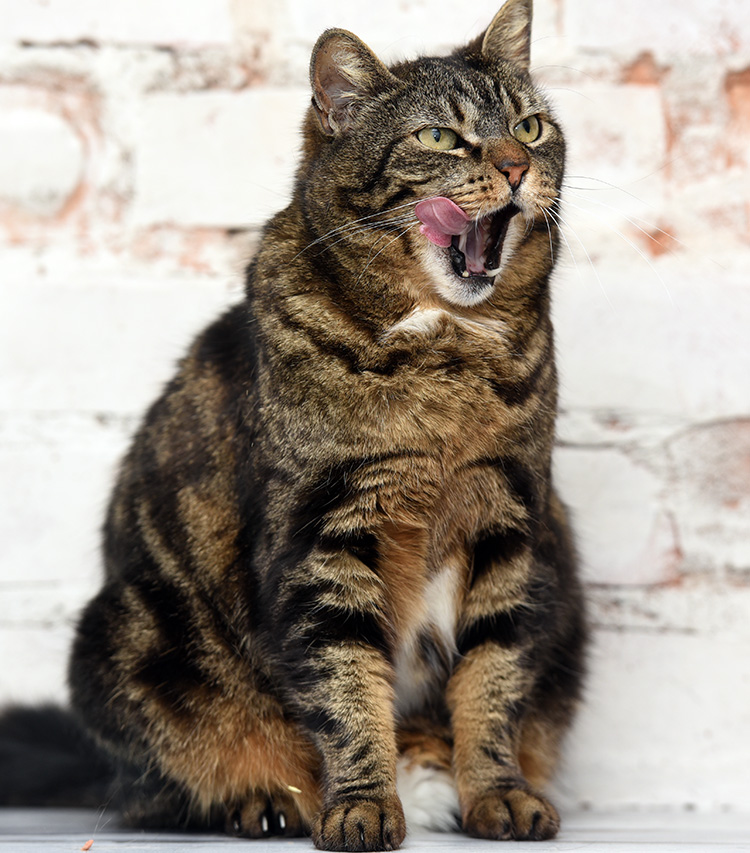
Obesity/Overeating has become epidemic among domestic cats today. The cause of obesity in an otherwise healthy cat is very straight-forward; they consume more calories daily than they can burn.
Did you know that obesity in cats has only arisen since the 1970s? Before the 70s, obesity in cats was rare. So what changed? It’s certainly not the amount of exercise, since cats sleep just as much today as they did then. The difference? Almost all cats were fed a meat-only diet in the form of canned foods. Today, however, many canned foods now contain plant products and starch/carbohydrates. Cats are obligate carnivores which means they must eat meat in order to thrive. Our domestic cats have NO nutritional requirement for starch/carbohydrates and plant proteins. Meat is your cat’s natural diet. It is what nature intended them to eat. In the wild, your cat’s source of food is small animals like mice and voles, not veggies or berries. In the 70s, there was a gradual conversion from a meat-only based diet (canned meat) to a diet that was half protein, half carbs with the protein portion containing significant plant proteins. These new diets were generally 30-35% protein, 10-15% fat and up to 35% starch/carbohydrates. For comparison, the nutritional profile of a juvenile mouse is generally 50-54% protein, 22-26% fat and less than 6% starch/carbs. The solution to prevent and reverse obesity is obvious; eliminate the starch/carbs and plant proteins.
Did you know it is not natural for your cat or for any predator to overeat? Think about it. If cats routinely over hunted in their environment, their food supply would collapse and they would eventually starve. Predators only eat what they need to live a healthy life. A fat cat in the wild would find it difficult to run fast enough or long enough to catch prey. And, climbing a tree to avoid a larger predator would be next to impossible. Obesity has also been shown to cause or increase the chances of other more serious medical issues. Let’s face it, your cat was never meant to be fat, nor was it meant to eat more than 6% carbs.
Your cat will naturally consume multiple meals each day. The time between meals is the interval when she digests and converts the food to energy to fuel her metabolism. Once she has converted food to energy, she will again become hungry and search for another meal. This would be perfect if the conversion of all food types into energy matched her use of that energy. Unfortunately, this is not the case, starch/carbs digest much more quickly than protein, dumping more energy into your cat’s system than she can use at one time. The excess energy is then converted and stored as fat. Your cat will eat another meal sooner than she would normally, because instead of using the stored fat, she wants more food. This starch/carb cycle continues to repeat itself until you have a fat kitty. Protein, on the other hand, digests much more slowly than carbohydrates and the speed at which your cat digests protein is perfectly matched to her metabolic needs. With protein, her metabolism remains synchronized to the time it takes her to convert protein to energy, no excess energy is produced so nothing is left to store as fat. Now when your cat is hungry again she will start with a neutral energy balance and the cycle of obesity is broken.
If your cat is overweight, it probably means the food she is currently eating is not balanced for her system. To ensure that your cat remains healthy, feed her as nature intended; 95% animal based protein/fat (50-54% protein, 22-26% fat) and less than 6% starch/carbohydrates. Follow these simple guidelines and your cat will maintain her optimal weight and you’ll enjoy a healthier, happier cat.